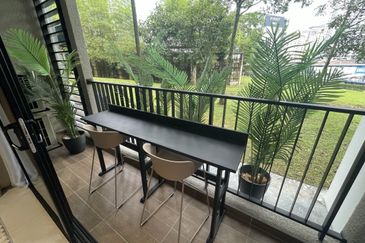
KUALA LUMPUR (March 10): An independent investigation into the deadly 2016 fire at Johor Bahru’s 137-year-old Sultanah Aminah Hospital revealed that it operated for years without a fire certificate.
A seven-member committee led by former Court of Appeal judge Mohd Hishamudin Yunus discovered that even with previous fires in the Ministry of Health (MOH) hospital since 2008, “the entire Sultanah Aminah Hospital management and the ministry did not appear to take fire safety seriously”, wrote the health website CodeBlue.
The Fire and Rescue Department (Bomba) also did not seriously enforce the law on HSA, revealed the independent inquiry’s 225-page report into the tragedy that was the source of CodeBlue’s story.
Six patients died when a fire broke out on Oct 25, 2016 at the South Intensive Care Unit (South ICU) ward of Sultanah Aminah Hospital.
It was also reported that none of the South ICU staff had training in fire drills or emergency evacuation despite the hospital suffering four previous fires.
The report also revealed that just two fire extinguishers were on hand at South ICU during the Oct 25, 2016 fire.
CodeBlue wrote that the two were “a CO2 fire extinguisher that was found to be ineffective for that type of fire and a powder fire extinguisher that malfunctioned at the critical moment”.
Meanwhile, the probe also touched on the Bomba’s inadequate response to the incident. Just one fire engine with a seven-member crew arrived at the scene, with the second arriving 26 minutes later, followed by the third 44 minutes later. The turntable ladder needed for fire-fighting operations arrived 50 minutes later.
But the report stated that under the Bomba’s “protocol, a fire like the one at HSA should have had three fire engines, equipped with a turntable ladder, arriving simultaneously at the scene within 10 minutes of the call for assistance”, wrote CodeBlue.
The electrical wiring at the main building of HSA that was at least 15 years old also came under scrutiny.
The investigating committee “believed that the immediate cause of the Oct 25, 2016 fire was due to electrical arcing, coupled with the presence of leaked medical gases rich in oxygen in the ceiling space of the storage room, where the fire was first spotted”, wrote the health website.
“The tragic incident of Oct 25, 2016 could have been avoided if the government had manifested grave concern over the conditions of the electrical cabling/wiring in the hospital and treat rewiring of the hospital with utmost importance,” said investigating committee.
The investigating committee also found that the Ministry of Health had in 2010 rejected HSA’s request for a special allocation for electrical rewiring owing to previous fires in South ICU since 2008
The ministry also denied funding for sprinkler and smoke detection systems.
In addition, the probe found that circuit protective conductors (CPCs) for the ICU electrical system had been disconnected from the earth terminal, which could result in an electrical fire during an overcurrent.
Citing Section 33C of the Electricity Supply Act 1990 and Regulation 34 of the Electricity Regulations 1994, “Disconnecting CPCs from the earth terminal is certainly a bad practice and an illegal act,” said the inquiry.
The design of the storage room where the fire broke out also went against by-law 139 of the Uniform Building By-laws 1984 or the Uniform Building By-laws 1986 of Johor (UBBL).
The six who died in the fire were C Neeramala Devi Chandran, 24-years-old; K Logeswaran, 20; Choo Lin Fung, 37; Tow Ah Wah, 60; Yusuf Hasan, 53; and M. Kaliama, 23.
According to reports, the six had died due to inhalation of carbon monoxide and severe burns
Last year, the parents of Neermala Devi filed a negligence suit against the Malaysian Government over the death of their in the fire.
P Chantiran and R Rajaswari also named the director of the Sultanah Aminah Hospital and the Johor health director as defendants.
According to a report by theedgemarkets.com, Chanthiran and Rajaswari in their suit claimed that their daughter, who worked in neighbouring Singapore, was seeking treatment at the ICU unit when the fire broke out.
They alleged that the defendants' failure or negligence to ensure proper maintenance, management of the safety and security of the building had resulted in her death while seeking treatment there.
The parents raised 16 points of negligence in their claim for damages for the loss of life, and they include failure by the hospital authorities and health department to ensure the safety of the facility, the maintenance and repair of electrical wire and electricity there; failure by the administrators of the hospital to have its staff ensure maintenance of the facility; and failure to ensure the safety of the building.
The other points of negligence include failure by the hospital to take steps to do the necessary repair of the existing facilities, failure to identify the problem, failure to remove the patients safely, failure to have or train its staff to handle such emergency when fire breaks out, and carelessness and negligence in taking standard safety steps.
For this reason, the family is seeking special damages of RM6,000 for funeral expenses as well as general damages to be assessed by the court, the costs of the action and other relief deemed necessary for their daughter's death.
TOP PICKS BY EDGEPROP

HiCom-Glenmarie Industrial Park
Shah Alam, Selangor

M Adora @ Wangsa Melawati
Wangsa Maju, Kuala Lumpur

M Adora @ Wangsa Melawati
Wangsa Maju, Kuala Lumpur

Sunway Rydgeway Puncak Melawati
Taman Melawati, Selangor

The Ridge, KL East
Taman Melawati, Kuala Lumpur

Kawasan Perindustrian Taman Johor
Johor Bahru, Johor

Taman Perindustrian Desa Cemerlang
Ulu Tiram, Johor


















